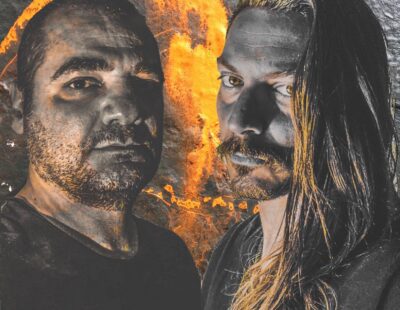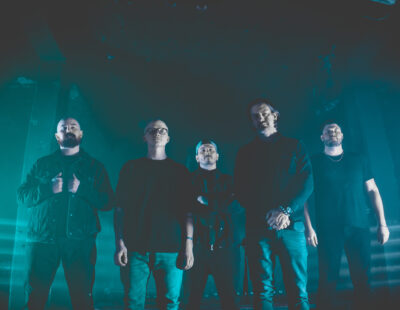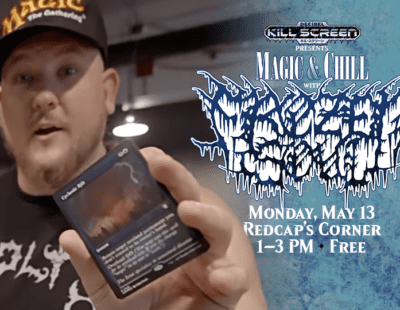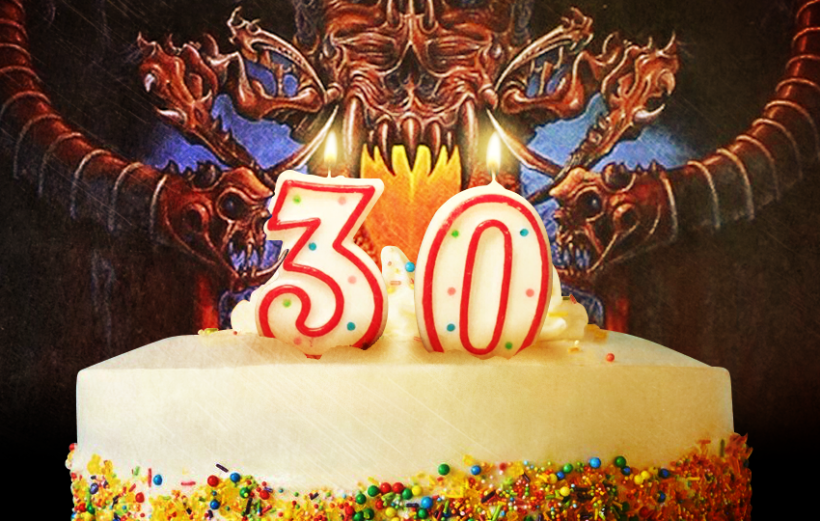
On this day of days, 30 years past, Swedish death metal powerhouse Dismember issued their unfuckwithable debut full-length, Like an Ever Flowing Stream, via burgeoning Germany-based indie Nuclear Blast. At the time, the impressionable Stockholmites had no idea they’d be joining their friends, colleagues and death metal legion in creating not just singular albums but a sound — no, sonic culture! — that would reverberate via pegged HM-2s and Dan Seagrave cover pieces decades later. But their eyes were on the prize, a label deal. This was, by all accounts, the goal, the dream. Dismember moved past Like an Ever Flowing Stream two years later with then-controversial Indecent & Obscene. Before disbanding in 2011 after 23 ever-flowing years, the Swedes had amassed eight full-lengths, establishing Dismember as not only quintessential purveyors of Svensk Dödsmetall but also as a true original.
Still, the enviable Like an Ever Flowing Stream wouldn’t die. Buried deep in the annals of time and dust, the heartbeat of Dismember’s first kill continued unabated. The ghastly gallop of “Override of the Overture,” “Bleed for Me,” “Dismembered” and “Sickening Art” defleshed any and all who encountered them. The terrifying thrum of “Soon to Be Dead,” “And So Is Life” and “In Death’s Sleep” devoured souls wantonly. This is death metal from those who were destined to make it. Art profane by Swedes growing up on and getting off to heavy metal and horror movies. That they were able to capture it over-driven and bursting at the seams with the help of Sunlight Studios wizard Tomas Skogsberg isn’t a minor marvel. Like their countrymen in Tiamat, Entombed, Carnage and Therion, they holed up at Skogsberg’s tiny, two-room studio to make death eternal.
Three decades later, Dismember’s Fred Estby is here to discuss thoroughly, laugh about, reminisce fondly and celebrate honorably Like an Ever Flowing Stream‘s proverbial pearl. Team Decibel couldn’t be more stoked, humbled and ready for it all. We originally inducted Like an Ever Flowing Stream into the Hall of Fame in August 2010, but since the issue is totally sold out, the only place to read further into the burial vaults of Dismember’s ace debut is to pick up our self-venerated Hall of Fame Anthology III (HERE) book. Or, you can read on and get the Anthology as Like an Ever Flowing Stream turns 30 today!
The 30th Anniversary of Like an Ever Flowing Stream is upon us. Time flies.
Fred Estby: Right?! Damn, I’m old but I don’t feel old! [Laughs] It feels like we recorded that album just a couple of years ago.
What was the demo-to-album period like for Dismember? The bands around Dismember had signed deals and put out albums. Tiamat, Carnage, Entombed, Grave and Unleashed, to name a few.
Fred Estby: It was an exciting time. The thing about it was that you could almost touch it. The feeling of it, right? Bands were getting signed and putting records out. A lot of bands I was tape-trading with, had seen live, or were pen pals with were getting signed. I mean, I knew they were good. They had good demos. This resulted in good albums coming out, too. So, it was amazing in that sense. I remember not being stressed about it though. Maybe I was impatient to get our album out? We were all working full-time and rehearsing together all the time. When we finally got Richard [Cabeza] and Robert [Sennebäck] onboard that’s when we really felt like we had a chance to get a label. We were a full band. We had a good demo. We sent the demo to Peaceville, Earache, Metal Blade, the usual labels. And they all rejected us! [Laughs] We were so annoyed. Then, Nuclear Blast hit us up, then it was like, “OK, here we go!”
I remember thinking about the quality of bands on Nuclear Blast though. They had bands, but the early Nuclear Blast bands didn’t, in my opinion, compare to the bands on Earache. But we were excited to finally get a deal. The timing felt like ages—I wanted to play shows, I wanted to record the album, I wanted us to be able to move forward. It was a fun time, actually. I was impatient, but I felt it was all going to turn out well.
What was the Nuclear Blast deal like?
Fred Estby: It was a crappy deal. We didn’t know any better. The label didn’t either. [Laughs] When I figured out what the contract was about after the first album, I managed to change it to a licensing deal. That meant we got to own our music. A lot of bands didn’t own their music. The Century Media bands signed their rights away for 10 albums. I remember being on tour with Grave asking them about renegotiating terms of their agreement. They were like, “No, it’s impossible now.” I guess it wasn’t about the money but more about having control over the music we’ve created.
What separated Dismember from the other Stockholm bands at the time? I’ve always felt Like an Ever Flowing Stream was more visceral, the riffs more tactile, the sound more serrated.
Fred Estby: Visceral? That’s a pretty good description. Never heard that before. I think we were different because we were all Iron Maiden fans. Not to say the other bands in Stockholm were not fans of Iron Maiden, but we felt we could incorporate heavy metal, even just a little bit. Back then, in Stockholm, it was not OK to have something even a little melodic. That was considered cheesy. We felt that if we tip-toed along that line that we’d have something pretty unique. I remember it clearly, actually. During rehearsals, we’d ask ourselves, “Is this too cheesy?” Quickly thereafter, I said to the other guys, “But is it good?” They said yes, and we suddenly had our answer. This little bit of heavy metal suited the songs. I guess, we still thought of it as cheesy, but eventually we thought nobody would notice or care. I came to that conclusion that things like this wouldn’t really matter too much. That felt good. We actually had something that was pretty unique to Dismember. It’s not like we’re doing hair metal. We were never that melodic. [Laughs]
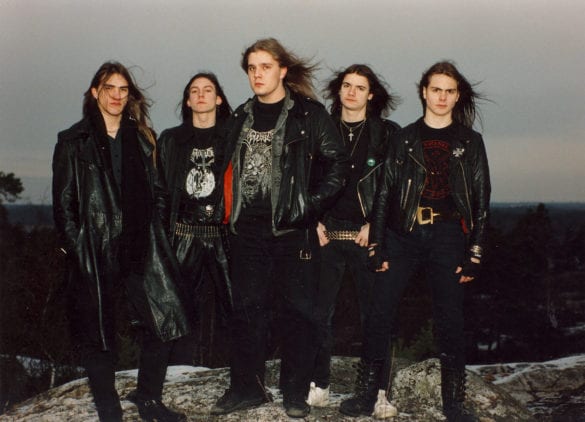
I agree. I also liked the production. Tomas Skogsberg’s production was so over-driven you could feel it. Again, it’s visceral, in your face, on your skin. I know you had a hand in that, too.
Fred Estby: That’s how it felt a little bit to us when we recorded it. I don’t know how the pieces fell together like that. I can’t explain how that all worked out. Tomas was really grasping how to get the sounds he wanted out of that studio [Sunlight Studio]. Sure, Carnage sounded great and Entombed sounded great, but I don’t think he or the bands he was recording we were really there yet sound-wise. Yet, I wouldn’t call it a fluke either. It’s not like we had months in the studio to sit back and analyze things. We never had room for second thoughts. It was like, “OK, guitars? Sound good? Done. What’s next? Let’s go!” There was no time for anything, really. Very fast operations at Sunlight. By early 1991, Tomas had refined things though. He was always a bit of a factory producer / recording engineer. Even when I worked there, he had at least two productions running seven days a week year round. No breaks! No vacation! [Laughs]
What do you remember about working with Tomas? He wasn’t a death metal guy. He’s a punk rock guy.
Fred Estby: Right, but don’t forget he’s really into The Beatles. Late-era The Beatles. He loved the Magical Mystery Tour. That was his go-to. David Bowie, too. He loved the productions of that time. That was his mindset. He knew how George Martin and David Bowie recorded. And read about them—he knew. He was a sponge in that sense. At the time, finding a recording facility for loud music in Stockholm was very hard. Tomas had a very small space in Stockholm—rent is pretty high in Stockholm as you probably know. Basically, he had two small rooms. You couldn’t fit a whole band in one of those rooms. The drum kit, and one more guy playing the pilot guitars. Of course, everything was overdubbed in those days. We didn’t play live together at Sunlight. Obviously, Tomas didn’t have a lot of money. He didn’t have compressors or tape recorders that were super-expensive—I remember, he had a couple of good mics—but most things in the studio were heavily modified by Tomas. He had the vocal mic spot. “His spot”. No changes. For death metal, it was like, this is the “X” on the speaker, this is the speaker we’re using, this is the pedal we’re using, and this is where you’re standing when you’re recording vocals. What I will say is he knew his equipment, and he knew it very well. I think the recording, in total, was something like 14,000 Swedish crowns, which is like 1500 bucks.
What kind of mixing desk did Tomas use?
Fred Estby: It was a transistor-based desk. A Seck, I believe. I think Seck eventually became the Mackie desk. Funny thing, he got a 110 volt but Sweden has 230 volts. So, he had to mod the desk to power it. As a result, it ran way hotter than it was supposed to. Back then, everything had character. Components were almost meant to be modded. Everything in Sunlight was modded and maxed out. Tape recorders—everything was all red! [Laughs] Today, you have to be careful, but back then you could push things as hot as you could. This gave the sound a bit of natural compression. I remember the mix down was so hot—we had hit peak limit—the mastering facility was really pissed off. They said, “Why are you guys mixing so hot?! We can’t do anything with this?!” I think they altered some frequencies, but we almost made their job unnecessary, which I thought was pretty funny.
I love that about the production on Like an Ever Flowing Stream. It’s almost as if it’s going to fall apart.
Fred Estby: Exactly! [Laughs] When David [Blomqvist] plays the fast stuff you can’t really hear what he’s playing. So many people have tried to do tabs to Like an Ever Flowing Stream. They always ask questions. Like, “Is this how you play it?!” We’re always like, “No! That’s not how you play it!” [Laughs] It’s really hard to hear the notes David is playing, but when his chords ring out they sound so massive. I love it! There’s a mid and low end that’s hard to get unless you push the sound hard.
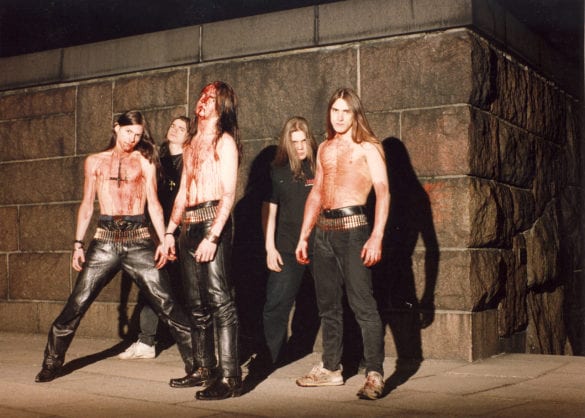
I’m sure you know about this but there’s heavy nerdery happening on the original presses of Like an Ever Flowing Stream. The German press has a different sound than the U.S. press. Back then, I had no idea my U.S. copy was audibly different from a German kid’s copy.
Fred Estby: It’s true! Back then, Tomas would give the digital audio tape (DAT) to the label. In this case, Nuclear Blast. So, obviously we didn’t do the mastering in Stockholm, which meant we never had control over the mastering. And I had no real idea about mastering any way. Of course, Nuclear Blast probably also didn’t know what to do with it either, so they just handed it off to the pressing plants. The pressing plants would then master it for vinyl and CD. So, the mastering and pressing of the album is different depending on which country you were in. I remember after we had recorded the Indecent & Obscene album, I went to visit Relapse, who, as you know, were doing Nuclear Blast at the time. I went to the mastering facility with Matt [Jacobson]. I had an “Aha!” moment after I talked to the mastering engineer there. Suddenly, I understood the importance of mastering.
Tell me about the photoshoots for Like an Ever Flowing Stream. The blood-covered band photos are stupendously great! I love the photo where Matti is hiding behind you.
Fred Estby: We had this photographer, Gottfried [Järnefors], who worked in a music store. We went to talk to him. He was older than us. He was a nice guy. He never asked for any money. When we asked what he thought about this blood idea we had, he just said, “OK, cool!” That was enough for us. He told us we should shoot at City Hall in Stockholm. We were like, “City Hall?! We’re gonna throw pig’s blood on us.” He was like, “No, no, you know behind City Hall? At night, nobody goes there.” There’s a bay [Riddarfjärden] there, so it’s just a place to stroll for older couples. It was March, I remember. It was cold. Nobody was out. He said to us, “Look, just go back there and do your thing with the blood. I’ll take the pics.” We knew we had to be quick. If security had shown up, I have no idea how they would’ve reacted. [Laughs]
So, me and Richard go to this butcher shop and we get a few plastic bags of frozen pig’s blood. At his mom’s house, we put it in the microwave oven. We defrosted that thing, took the bags of blood to City Hall, took off our shirts, and poured it all over us. It was like, “Alright! Shoot!” What we didn’t realize is that when pig’s blood dries on you—and it does so very quickly—it sticks to your skin, it sticks to your leather pants, it cakes your hair. It’s like paint. We didn’t really think it through too much. After the photoshoot, we knew we had to get the blood off of us. There’s no way we could get on the train like this. [Laughs] So, we tried to wash off the blood in the bay. It was so cold. That didn’t go too well. [Laughs] I remember, I was on the train for like an hour going to my girlfriend’s place. People were staring. The pig’s blood stunk! I was reeking of it. People were leaving the train car. After a couple of stations, I was the only one in the train car. [Laughs] I had to sneak into my girlfriend’s parents’ house. When she opened the door, she almost had a heart attack. She was like, “My parents can’t see you like this!” So, I had to go around to the back door to clean up.
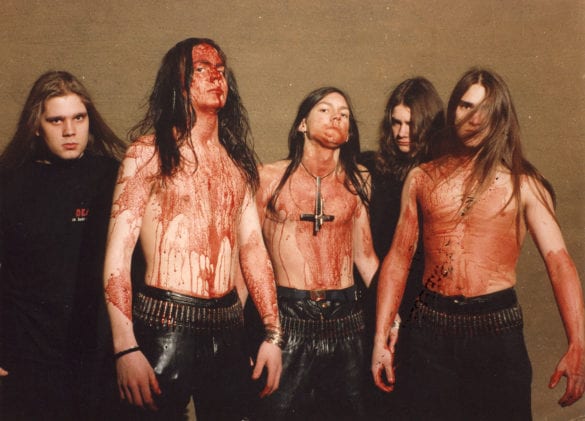
I love that Matti’s in the background in the photo. He looks so mischievous yet not at all wanting to be involved.
Fred Estby: [Laughs] He didn’t! Neither did David. They were like, “We don’t want pig’s blood on us!” We were like, “Come on!” They wanted nothing to do with it. There are a couple photos where Matti and David are separated from us, but that was a lucky shot. I remember getting the original photo. I had to go this photo copy place for it to be cut manually so we could express it out to Nuclear Blast. We only had one photo. We didn’t scan stuff back then. We had to develop the film, make sure it was the right exposure, blow it up to the right proportions. It was work, man. [Laughs]
How much input did you have on the Dan Seagrave cover?
Fred Estby: Not much. The label said, “We want Dan Seagrave to do the cover.” He had done a lot of great covers like Morbid Angel and Entombed. We were, of course, really happy about that. He was exactly what we wanted. I asked the label if I could get in touch with Dan while he was working on the cover. Me and Nicke Andersson were thinking about ideas for cover. I was working at this small music distribution company / warehouse called Chicken Brain Records (or CBR, as you might know it). They had a fax machine. So, I faxed Dan our ideas. I don’t think they were considered, but I do remember when Nuclear Blast had finally gotten the cover art. They said, “Well, we can fax it to you.” Of course, I said “Yes!” I could barely see what it was but I was so excited. [Laughs] It was nothing like I had envisioned but I could tell it was going to be really good.
Like an Ever Flowing Stream ended up a classic. The cover. The logo. The band photos. The studio. The production. The album title. The music. I know I’m talking about something that happened 30 years ago, but it’s really fucking special. It totally holds up.
Fred Estby: Lucky us. [Laughs] I remember when Matti came to the rehearsal space with the title. I thought, “Well, this is poetic, but it doesn’t sound cheesy or stupid.” I think Dan had the title when he did the cover. Most of the albums that came out around that time were also classic. Entombed’s first album. That photoshoot with the cross. I mean, it’s a normal cemetery [Skogskyrkogården], but we never thought about taking photos there. Then, they took that pic. Now, it’s iconic. It’s so great!
Did you ever think Like an Ever Flowing Stream would have this long of an impact?
Fred Estby: Not then. Absolutely not. We were impatient. We wanted the album out. We wanted to get on the road. We wanted to write another album. I have a distinct memory that someone from Nuclear Blast called me after a short tour. You know, the kind with lots of ups and downs. When we came back from tour, Nuclear Blast called me and told me we had sold 25,000 copies after a month of release. I was like, “Are you insane?! Are you sure you’re reading the numbers correctly?!” I couldn’t fathom what he was saying to me. Back then, 10,000 copies was a major deal. A magic sales number. I don’t know how correct the numbers were, but in our young minds, we were up there with Pungent Stench. I do believe this person was eventually told off by Markus [Staiger]. He didn’t want us to get big heads, I think. We were totally young and naïve. We weren’t in this for the money. It was death metal or nothing!




